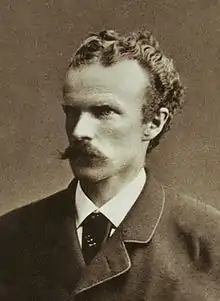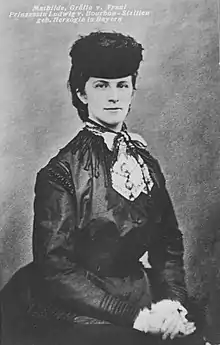Duke Maximilian Joseph in Bavaria
Duke Maximilian Joseph of Bavaria (4 December 1808 – 15 November 1888), known informally as Max in Bayern, was a member of a junior branch of the royal House of Wittelsbach who were Kings of Bavaria,[1] and a promoter of Bavarian folk-music. He is most famous today as the father of Empress Elisabeth of Austria ("Sisi") and great-grandfather of King Leopold III of Belgium.
| Maximilian Joseph | |
|---|---|
| Duke in Bavaria | |
.jpg.webp) | |
| Born | 4 December 1808 |
| Died | 15 November 1888 (aged 79) |
| Spouse | |
| Issue |
|
| House | Wittelsbach |
| Father | Duke Pius August in Bavaria |
| Mother | Princess Amélie Louise of Arenberg |
Life
Maximilian Joseph was born at Bamberg, the only son of Duke Pius August in Bavaria (1786–1837) and his wife, Princess Amélie Louise of Arenberg (1789–1823). On 9 September 1828, at Tegernsee, Maximilian Joseph married Princess Ludovika of Bavaria, the sixth daughter of King Maximilian I Joseph of Bavaria, his father's cousin. They had ten children.
In 1834 he purchased Possenhofen Castle on Lake Starnberg; this was his major residence for the rest of his life. In 1838 he acquired Unterwittelsbach Castle (today housing a "Sisi" museum) near the site of Burg Wittelsbach, the ancestral seat of the House of Wittelsbach. Maximilian Joseph died in Munich. He and his wife are buried in the family crypt in Tegernsee Abbey, a former monastery which Ludovika's father, King Maximilian I Joseph, had acquired in 1817. At the same time of the secularisation, Duke Maximilian Joseph's grandfather Duke Wilhelm in Bavaria had also purchased a former monastery, Banz Abbey. Both properties, Tegernsee and Banz, are still today owned by Prince Max, Duke in Bavaria.

 Unterwittelsbach Castle
Unterwittelsbach Castle
 The house of Duke Maximilian Joseph in Munich
The house of Duke Maximilian Joseph in Munich
Middle East trip
In 1838 Maximilian Joseph travelled to Egypt and Palestine.[2] He published an account of this trip: Wanderung nach dem Orient im Jahre 1838 (München: Georg Franz, 1839; reprinted Pfaffenhofen: Ludwig, 1978). While climbing the Great Pyramid, he arranged for his servants to yodel as if he were climbing in the Alps. He collected a number of antiquities which he brought back to Bavaria and displayed in his father's home, Banz Abbey; they can still be seen there today. Among the items are the mummy of a young woman, three mummies' heads, several animal mummies, shawabtis, and several stones from tombs or temples including one from the Temple of Dendur. He also bought some children in the Cairo slave market and later freed them. When Maximilian Joseph was in Jerusalem, he paid for the restoration of the Church of the Flagellation on the Via Dolorosa.
Folk-music
Maximilian Joseph was one of the most prominent promoters of Bavarian folk-music in the 19th century. Under his influence the zither started to be used in court circles and eventually became identified as the national musical instrument of Bavaria. Because of his interest he received the nickname Zither-Maxl. He himself played the zither and also composed music for it.
During a visit by his cousin Ludwig II of Bavaria, Ludwig saw some sheet music on Maximilian Joseph's piano by the composer Richard Wagner, which led on to Ludwig's financial support for Wagner from 1863.
Maximilian Joseph's musical compositions have been collected in the work: Die im Druck erschienenen Kompositionen von Herzog Maximilian in Bayern: Ländler, Walzer, Polka, Schottisch, Mazurka, Quadrillen und Märsche für Pianoforte, Zither, Gitarre oder Streichinstrumente (München: Musikverlag Emil Katzbichler, 1992).
Issue
| Issue | ||||
|---|---|---|---|---|
| Name | Portrait | Lifespan | Notes | |
| Ludwig Wilhelm ("Louis") |
 |
21 June 1831 – 6 November 1920 |
Married twice (morganatically): 1. Henriette Mendel, Freiin von Wallersee (1833–1891) in 1859 Issue: 1 daughter, 1 son. 2. Barbara Antonie Barth, Frau von Bartolf (1871–1956) in 1892, divorced 1913 Issue: None. | |
| Wilhelm Karl |
24 December 1832 – 13 February 1833 |
Died in infancy | ||
| Helene Caroline Therese ("Nene") |
 |
4 April 1834 – 16 May 1890 |
Married Maximilian, Hereditary Prince of Thurn and Taxis (1831–1867) in 1858 Issue: 2 daughters, 2 sons. | |
| Elisabeth Amalie Eugenie ("Sisi") |
 |
24 December 1837 – 10 September 1898 |
Married Francis Joseph, Emperor of Austria (1830–1916) Issue: 3 daughters, 1 son. | |
| Karl Theodor ("Gackl") |
 |
9 August 1839 – 30 November 1909 |
Married twice: 1. Princess Sophie of Saxony (1845–1867), his cousin, in 1865 Issue: One daughter. 2. Maria Josepha of Portugal (1857–1943) Issue: 3 daughters, 2 sons. | |
| Marie Sophie Amalie |
 |
4 October 1841 – 19 January 1925 |
Married Francis II, King of the Two Sicilies (1836–1894). Issue: 1 daughter. | |
| Mathilde Ludovika |
 |
30 September 1843 – 18 June 1925 |
Married Lodovico, Count of Trani (1838–1886) Issue: 1 daughter. | |
| Maximilian |
8 December 1845 | Stillborn | ||
| Sophie Charlotte Augustine ("Sopherl") |
 |
23 February 1847 – 4 May 1897 |
Married Ferdinand Philippe Marie, Duke of Alençon (1844–1910) Issue: 1 daughter, 1 son. | |
| Maximilian Emanuel ("Mapperl") |
 |
7 December 1849 – 12 June 1893 |
Married Princess Amalie of Saxe-Coburg and Gotha (1848–1894) Issue: 3 sons. | |
Honours
He received the following orders and decorations:[3]
.svg.png.webp) Kingdom of Bavaria: Knight of the Order of Saint Hubert
Kingdom of Bavaria: Knight of the Order of Saint Hubert Grand Duchy of Hesse: Grand Cross of the Grand Ducal Hessian Order of Ludwig, 26 November 1849[4]
Grand Duchy of Hesse: Grand Cross of the Grand Ducal Hessian Order of Ludwig, 26 November 1849[4].svg.png.webp) Kingdom of Prussia: Knight of the Order of the Black Eagle, 20 November 1841[5]
Kingdom of Prussia: Knight of the Order of the Black Eagle, 20 November 1841[5].svg.png.webp) Kingdom of Saxony: Knight of the Order of the Rue Crown, 1864[6]
Kingdom of Saxony: Knight of the Order of the Rue Crown, 1864[6] Austrian Empire:[7]
Austrian Empire:[7]
- Grand Cross of the Royal Hungarian Order of Saint Stephen, 1853
- Knight of the Distinguished Order of the Golden Fleece, 1854
.svg.png.webp) Kingdom of Greece: Grand Cross of the Order of the Redeemer
Kingdom of Greece: Grand Cross of the Order of the Redeemer.svg.png.webp) Two Sicilies: Grand Cross of the Illustrious Royal Order of Saint Ferdinand and Merit
Two Sicilies: Grand Cross of the Illustrious Royal Order of Saint Ferdinand and Merit
Ancestry
| Ancestors of Duke Maximilian Joseph in Bavaria | |||||||||||||||||||||||||||||||||||||||||||||||||||||||||||||||||||||||||||||||||||||||||||||||||||||||||||||||||||||||||||||||||||||||||||||||||||||||||||||||||||||||||||||||||||||||||||||||||||||||||||||||||||||||||||||||||||||||||||||||||||||||||||||||||||||||||||||||||||||||||
|---|---|---|---|---|---|---|---|---|---|---|---|---|---|---|---|---|---|---|---|---|---|---|---|---|---|---|---|---|---|---|---|---|---|---|---|---|---|---|---|---|---|---|---|---|---|---|---|---|---|---|---|---|---|---|---|---|---|---|---|---|---|---|---|---|---|---|---|---|---|---|---|---|---|---|---|---|---|---|---|---|---|---|---|---|---|---|---|---|---|---|---|---|---|---|---|---|---|---|---|---|---|---|---|---|---|---|---|---|---|---|---|---|---|---|---|---|---|---|---|---|---|---|---|---|---|---|---|---|---|---|---|---|---|---|---|---|---|---|---|---|---|---|---|---|---|---|---|---|---|---|---|---|---|---|---|---|---|---|---|---|---|---|---|---|---|---|---|---|---|---|---|---|---|---|---|---|---|---|---|---|---|---|---|---|---|---|---|---|---|---|---|---|---|---|---|---|---|---|---|---|---|---|---|---|---|---|---|---|---|---|---|---|---|---|---|---|---|---|---|---|---|---|---|---|---|---|---|---|---|---|---|---|---|---|---|---|---|---|---|---|---|---|---|---|---|---|---|---|---|---|---|---|---|---|---|---|---|---|---|---|---|---|---|---|---|---|---|---|---|---|---|---|---|---|---|---|---|---|---|---|---|
| |||||||||||||||||||||||||||||||||||||||||||||||||||||||||||||||||||||||||||||||||||||||||||||||||||||||||||||||||||||||||||||||||||||||||||||||||||||||||||||||||||||||||||||||||||||||||||||||||||||||||||||||||||||||||||||||||||||||||||||||||||||||||||||||||||||||||||||||||||||||||
Notes
- Annual Register. J. Dodsley. 1887. p. 142.
- Gabriele and Jochen Hallof, "Dendur: The Six-Hundred-Forty-Third Stone", Metropolitan Museum Journal 33 (1998): 103–108
- Hof- und Staatshandbuch des Königreichs Bayern: 1886. Landesamt. 1886. p. 147.
- Hof- und Staats-Handbuch des Großherzogtum Hessen (1879), "Großherzogliche Orden und Ehrenzeichen" p. 10
- "Von Seiner Majestät dem Könige Friedrich Wilhelm IV. ernannte Ritter", Liste der Ritter des Königlich Preußischen Hohen Ordens vom Schwarzen Adler (in German), Berlin: Decker, 1851, p. 22
- Staatshandbuch für den Freistaat Sachsen: 1873. Heinrich. 1873. p. 4.
- "Ritter-Orden", Hof- und Staatshandbuch der Österreichisch-Ungarischen Monarchie, 1888, pp. 78, 84, retrieved 5 April 2021
Bibliography
- Dreyer, Aloys. Herzog Maximilian in Bayern, der erlauchte Freund und Förderer des Zitherspiels und der Gebirgspoesie. München: Lindauer, 1909.
- Damien Bilteryst, Olivier Defrance, Joseph van Loon: Les Biederstein, cousins oubliés de la reine Élisabeth, années 1875-1906. Museum Dynasticum, Bruxelles, XXXIV/1 2022.
- See also parts of Furst und Arzt : Dr. med. Herzog Carl Theodor in Bayern : Schicksal zwischen Wittelsbach und Habsburg by Richard Sexau, a biography of his son Karl Theodor (Styria Verlag, Graz, 1963)
External links
- Marek, Miroslav. "A listing of descendants of the House of Pfalz-Zweibrücken-Birkenfeld". Genealogy.EU.